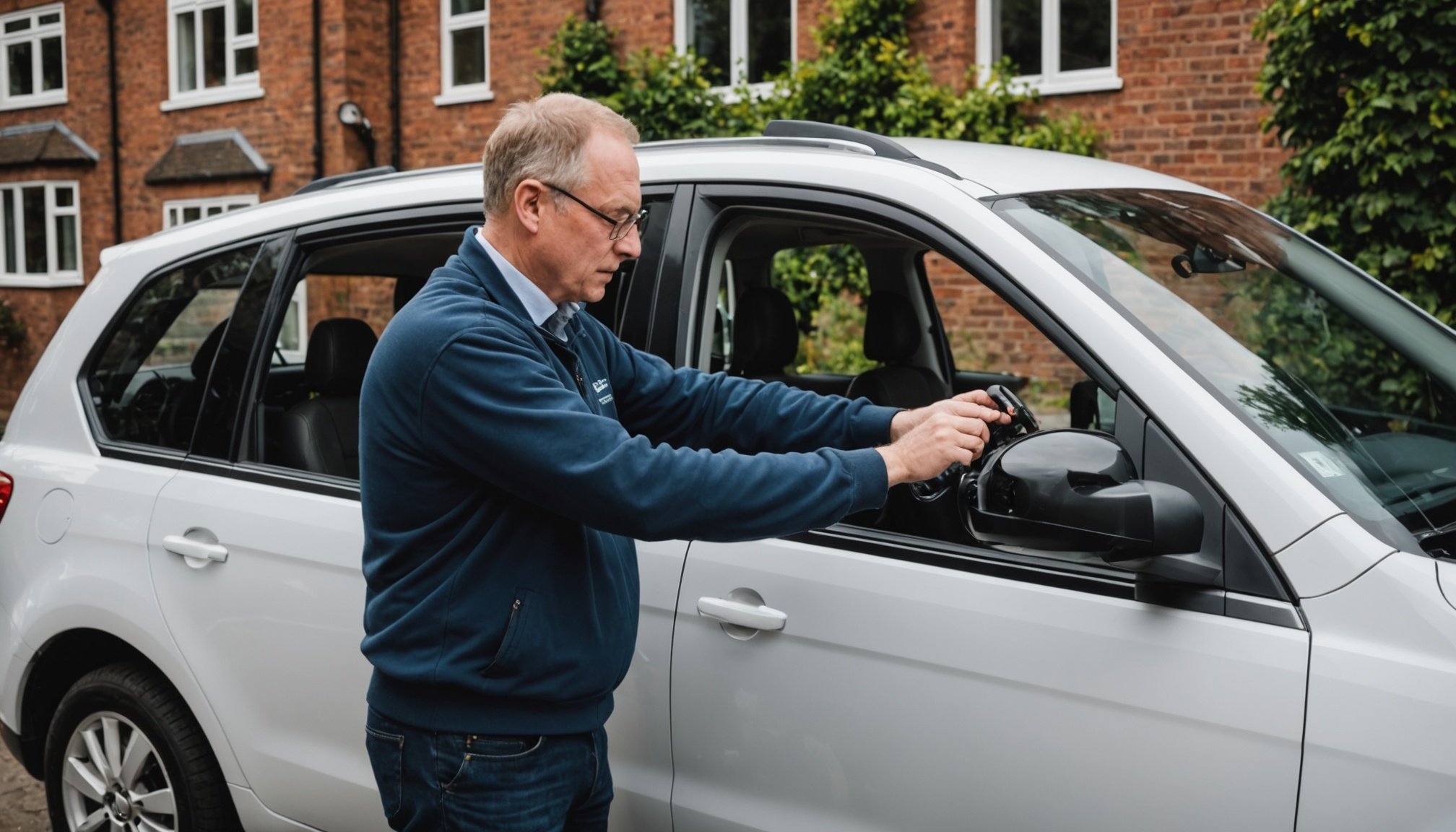Overview of Electric Window Systems
Electric window systems have become standard in many UK vehicles, offering convenience and modernity. Understanding the basics of these systems is essential, especially before embarking on any troubleshooting efforts.
At the core, an electric window system comprises several common components: an electric motor, a window regulator, switches, and wiring that connects these elements. The electric motor powers the window’s movement, while the window regulator ensures smooth and controlled motion. The switches serve as user interfaces, allowing easy control within the vehicle cabin.
Also to discover : What are the signs that your car’s battery needs to be replaced?
Moving on to how electric windows work in UK vehicles, the process is notably straightforward. When a switch is activated, an electrical signal is sent to the motor via the wiring. This signal prompts the motor to turn, which in turn engages the window regulator, guiding the window glass upwards or downwards.
Understanding the system’s intricacies is crucial before attempting any troubleshooting. A fundamental grasp of how these components interact ensures effective problem diagnosis and resolution. Recognising the signs of wear or malfunction within these parts can often preempt more significant issues. Thus, familiarising oneself with electric window systems’ operation can save time and resources.
Topic to read : Ultimate Guide to Soundproofing Your Car Cabin in the UK: Tips for a Quieter Ride
Common Faults with Electric Windows
Electric windows have revolutionised convenience, but they aren’t immune to issues. Troubleshooting electric windows starts with understanding common electric window faults. One frequent issue is unresponsive switches. Often, switches fail due to disconnection, wear, or electrical shortages, disrupting window operations.
Another prevalent problem is slow or erratic window movement, often caused by a weakened motor or mechanism obstruction. Granular debris and grime can cause friction, hindering smooth operation. Signs indicating electric window problems include unusual noises during window movement, which might suggest gear or motor malfunctions.
Weather and temperature significantly impact electric window functionality. Cold weather can cause windows to operate sluggishly as lubricants thicken, while extreme heat may warp window seals, leading to poor insulation and noise ingress. Electric window troubleshooting must account for these environmental effects, ensuring regular maintenance and appropriate lubrication.
Common issues also involve alignment discrepancies where windows don’t fit snugly into frame tracks. This misalignment can lead to air leaks and water ingress, especially in adverse weather conditions. Periodic inspections and realignments can prevent these from becoming more serious faults. Understanding these factors is crucial for maintaining reliable electric window performance, ensuring comfort and security in your vehicle.
Tools Required for Diagnosis and Repairs
When diving into the world of DIY car repair, it’s crucial to be equipped with the right arsenal of tools to ensure your efforts are both effective and safe.
Essential Tools for Troubleshooting
For electric window repair, possessing basic automotive tools like a multimeter is essential. This device helps diagnose electrical issues by measuring voltage, current, and resistance, allowing you to pinpoint faults within the system. Additionally, owning a test light can simplify the detection of power presence in circuits. Socket sets and screwdrivers tailored for automotive use are fundamental for dismantling door panels with ease.
Additional Tools for Repair
Beyond the basics, certain special tools can significantly aid in specific repairs. A window crank removal tool is invaluable for models with manual windows. Similarly, trim removal tools help prevent accidental damage to delicate parts. Ensure you have a wire stripping and crimping tool for seamless electric wire maintenance.
Safety Equipment
While focusing on effective diagnoses and repairs, never underestimate the importance of safety equipment. Wearing safety goggles shields your eyes from unexpected debris. Gloves provide protection and improve grip, ensuring precision during intricate operations. Remember, safety is as vital as skill in DIY car repair.
Step-by-Step Troubleshooting Process
Diagnosing electric windows can sometimes seem daunting, but with a troubleshooting process, you can systematically identify and resolve issues.
Initial Checks Before Advanced Troubleshooting:
Before delving into in-depth diagnostics, perform simple checks. Ensure the car’s ignition is on, and the window lock function isn’t engaged—common oversights that can mimic deeper problems. A quick inspection of fuses related to the window circuit can also reveal blown fuses, often the culprit behind unresponsive windows.
Sequential Troubleshooting Steps for Common Issues:
Once initial checks are cleared, proceed with further steps. Consider whether the issue is isolated to one window or multiple. Test the switch by operating it on different doors, if available, to rule out switch faults. Inspect window tracks for obstructions that might hinder movement. Should these steps yield no solution, checking the wiring and motor requires more technical knowledge but is a logical follow-up.
Importance of Systematic Diagnosis in Effective Repairs:
Adopting a methodical approach not only prevents overlooking minor issues but also saves time. A systematic diagnosis ensures each potential problem area is explored and resolved, leading to effective repairs. For those new to car repairs, a structured troubleshooting process supports urgency in getting back on track while building expertise.
Repair Techniques for Electric Window Problems
Electric window issues in your car can be frustrating, but they are usually fixable with the right approach. Understanding fixing electric windows involves several key repair techniques that can effectively restore functionality. Let’s delve into these methods to help you get your car window repair underway.
Replacing Fuses
The first step in addressing electric window problems is examining the fuses. A blown fuse is a common reason for window failures. To check, locate the fuse box, usually found under the dashboard. Identify the window fuse, using the car’s manual as a guide. If the fuse has blown, replace it with one of the same rating, ensuring the connection is secure.
Checking and Replacing Wiring
Wiring issues can also prevent windows from functioning. Inspect the wiring for any signs of wear or damage. If you find exposed wires or corrosion, consider replacing the affected section. Proper installation and connection are crucial to avoid recurrent issues.
Motor Replacement
When the motor fails, window movement is impossible. Disconnect the battery, remove the door panel carefully, and access the motor. Securely install the new motor as improper fitting can cause further malfunctions. Sourcing quality replacement parts is vital for long-term dependability. Building expertise in these techniques ensures smooth electric window operation.
Visual Aids and Resources
Understanding car repair tasks can feel daunting, but visual aids for car repair provide essential clarity and guidance. Diagrams for troubleshooting are particularly valuable, as they offer a clear visual representation of components and their connections. These diagrams help both beginners and seasoned DIY enthusiasts pinpoint problems with confidence. When you’re uncertain about a step or part, these resources quickly illuminate the task at hand, enhancing both the accuracy and speed of repairs.
Instructional videos are another invaluable resource, showcasing repairs in action with real-time demonstrations. For those who learn best by watching others, these videos cover a wide range of repairs. Platforms like YouTube host countless tutorials from reputable mechanics, catering to various models and difficulty levels. Visual learners can pause, rewind, and replay sections, ensuring they truly grasp each repair stage.
Moreover, don’t overlook local resources for further assistance. Many community centers offer workshops or advice sessions, where experienced mechanics share hands-on tips. Libraries often stock vehicle manuals with comprehensive diagrams for troubleshooting, aiding deeper understanding. By leveraging both digital and local resources, individuals can enhance their repair skills significantly, increasing both self-reliance and satisfaction.
Adhering to Local Regulations
When engaging in DIY car repairs in the UK, it is vital to adhere to specific vehicle regulations to ensure safety and legality. The UK’s car repair laws are designed to safeguard both the vehicle owner and other road users, making compliance crucial. Understanding these laws is essential because non-compliance can lead to legal penalties or even invalidated insurance coverage.
The safety standards for vehicles in the UK are stringent, covering various aspects from emissions to braking systems. DIY enthusiasts must familiarize themselves with these regulations to avoid contravening any laws during repairs. Particular attention should be paid to modifications, as altering any integral part of the vehicle without proper permits or certifications can lead to severe consequences.
For those seeking guidance, numerous resources provide valuable insights into UK vehicle regulations. The Driver and Vehicle Standards Agency (DVSA) offers comprehensive information about the standards required. Meanwhile, local car clubs or forums can provide peer support, sharing experiences and advice on specific compliance issues.
In summary, while DIY repairs can be a fulfilling endeavour, ensuring that your vehicle meets UK regulations is paramount. Investing time in understanding and adhering to these standards not only promotes safe driving but also protects you from potential legal issues.











